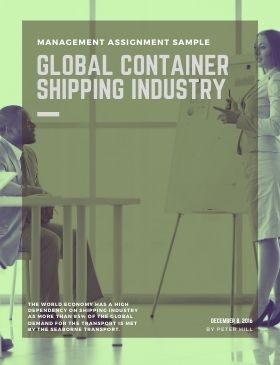Supply chain management Assignment Help Samples
You can download the solution to the following question for free.
For further assistance in Supply chain management help, please check our offerings in Supply chain management assignment solutions. Our subject-matter-experts provide online assignment help to finance students from across the world and deliver plagiarism free solution with free Turnitin report with every solution.
(AssignmentEssayHelp do not recommend anyone to use this sample as their own work.)
Question
Based on the research topic you have selected for your project, submit the following Chapters of the project report:
Framework of the five chapters
Chapter 1: Introduction, including research background, problem identification, research question(s) and research objective(s)
Chapter 2: Literature Review, including a critical and integrated review of existing literature in terms of your research problem and research objective(s)
Chapter 3: Research Methods for Data Collection, including data collection methods and sampling strategy
Chapter 4: Data Analysis and Findings, including the description of the actual data set (where applicable) and analysis results
Chapter 5: Implications and Conclusion, including implications of the findings, limitations of your study (if any) and recommendations for future research.
In addition to the five chapters, your project should also contain the following:
Cover page (see 'notes: no 2' on page 24)
Solution
The world economy has a high dependency on shipping industry as more than 85% of the global demand for the transport is met by the seaborne transport. Shipping industry has played a vital role in transporting 90% of the world's food, product and fuel from refrigerated freighters, container ships, car carriers and super tankers. (Glassman, 2013) However, when we talk about the shipping industry, it is not only about the container carriers. The entire shipping cycle has various stakeholders involved in it; segregated on the basis of key value chain activities. Before, we move ahead on developing our research theme, let's first understand the shipping industry value chain-
 Figure 1: Container Shipping Industry Value Chain, Source: (MergeGlobal, 2008)
Figure 1: Container Shipping Industry Value Chain, Source: (MergeGlobal, 2008)
As shown in the above diagram, end to end shipping cycle (Movement of container from shipper to consignee) is divided into 5 main activities, based on which the shipping industry would have following categorization for the various operators. Revenue share for the FY 2007 is also shown for the various segments and the ROCE (return on capital employed) is also indicated in the diagram. Note that there are players who operate in all the segments of the value chain wherein few entities operate in a standalone manner by focusing on a single segment of the value chain.
Shipping Origination: This segment represents the retail level operations of the container shipping industry. Main activities in this segment are customer sales, forming customer contracts for payment of door-to-door transportation, billing and tracking shipments. Freight forwarders and shippers are two main competitors in this segment. Container carriers also known as liner companies own the ships/containers and do manage their own shipping orientation services. In contrast, forwarders depend on the other companies to move their containers from end to end locations. Owning the container/shipping provides an added advantage of the guaranteed capacity to carriers during peak demand time. Whereas forwarders hold advantage of pick and choose from the carriers and routing options to meet their shipping requirements. Estimated ROCE is the highest for this segment as compared to other segments of the value chain. High ROCE indicates that the capital requirement for the players in this segment is limited to owning container shipping facilities (applicable for container carriers), spend on the information technology (for billing, shipment tracking and customer sales) and capital to cover operations to manage the gap between payment cycle (difference between account payable and receivables). (MergeGlobal, 2008)
Container Providers: This segment of the value chain consists of ownership, leasing, storage services and maintenance of the containers and chassis. Players in this value chain segment are termed as Container Carriers. Containers are either purchased and maintained by the carriers internally or they may opt to outsource these services. Maersk Line, CMA CGM and Mediterranean Shipping Co. are three major container operators. They hold more than 27% of the trade in US laden container trade. (The Journal of Commerce, 2013) The common strategy adopted by the container carriers is mixed fleet strategy wherein the portion of the container maintenance work is outsourced to third party vendors. This segment of the industry is highly capital intensive; and increasing fleet capacity would mean more capital required for the maintenance. ROCE for this segment stands at around 9%.
Vessel Operators: Vessel operators own the ships and operate the ship transport from quay to quay. Vessel operators either provide their own ships to carry out the shipping operations or they lease out the ships to other container operators. Other activities performed by the vessel operators include managing the vessel crew, paying navigation charges, spending on harbour pilot services, etc. Vessel operation is also a capital intensive industry with estimated ROCE of around 3%. One of the reasons for the low ROCE is the utilization of the shipping capacity. Globally, container carriers operate at around 48% of their owned slot capacity and lease out the remaining capacity to the other freight forwarders.
Terminal and Port Operators: The forth important segment of the shipping value chain is the port and terminal operations. The major activities in this segment are loading and unloading containers from vessels, storage of the containers at the terminals, loading containers for inland transport, etc. Terminal port operations are considered to be the high risk activities and major spend is incurred in ensuring the safety of the terminal crew and container material. Estimated ROCE for this segment is at around 25%. Major shipping players handle their own terminal and port operations to assure guaranteed birthing capacity in vessels. For example, APM terminals is an entity owned by Maersk Line group which manages the terminal and port operations for Maersk Line and other container carriers.
Inland Delivery/ Container Inland Services (CIS): The final segment in the shipping value chain is Inland services which is responsible for movement of containers from the ports to the consignee. Container carriers generally rely on the separate entities to manage the inland transport of the containers from ports to the destination. These activities are least integrated with the other operations which are highly asset intensive and thus experience a relatively higher ROCE.
The focus of this research is mainly on the container carriers responsible for transporting containers from source to destination. Maersk Line, CMA CGM S.A., China Shipping Container Lines and Mediterranean Shipping Company are the major container carriers which are referred frequently in this research document.
Research Problem Identification:
Research problem explains the knowledge gap to be addressed by the research. In the context of this research, the research problem would address the issues related to the financial and operational issues faced by the container carriers and the way ahead for them.
Global container shipping industry passed through a tough year in 2012. The growth rate in the global container traffic was significantly lower due to the volatile world economy. (Jarurungsipong & Rakthum, 2012) The global container shipping industry has witnessed a significant imbalance between supply and demand which is caused by the global financial crisis. Key regional economies across the globe have experienced a significant financial slowdown imposing persistent financial and operational challenges ahead of global carriers. Direct impact of these financial anomalies is fall in the freight rates and erosion of profit margins for the container carriers. (Jarurungsipong & Rakthum, 2012)
However, there exists a dual relationship between the world economy and the shipping operators. Undoubtedly, the Shipping industry has the most impact on the growth of the global economy. 90% of the world's food, products and energy are transported via shipping containers. Every year more than 86,000 ships transport 9 billion tons of cargo across our seas. To put things in perspective, this means more than a ton of transport for each person. Such, is the impact of the shipping operators on the mechanics of demand and supply. If the demand supply gap exceeds more than 2% the operations of the shipping operators destabilize. In addition to destabilizing global economic events, shipping industry has witnessed challenges of brutal competition and chronic over-capacity in last 12-18 months. Well, the impact of the performance of the shipping operators on world trade is huge. To establish connect with our day to day operations, some 99% of the goods one can see at Walmart are shipped via containers. Thus, understanding the outlook of the global shipping industry is not only limited to the performance of the major players, but it has added dimensions such – understanding the global trade, demand-supply mechanics, transport of the goods across the globe, etc. These added dimensions extend the scope this research making it more important and indeed interesting. (Glassman, 2013)
Research Question:
An important step in conducting any research is to formulate a research question. The research question is about the problem to be addressed. Research question summarizes the main issues to be addressed in the research. In the context of global container shipping industry, the research theme revolves around-
- the financial and operating challenges faced by the global container carriers,
- recognition of the current trend in the industry,
- understanding the impact of technological advancement,
- determine the industry outlook based on the prior trend and………….



 WhatsApp Us
WhatsApp Us